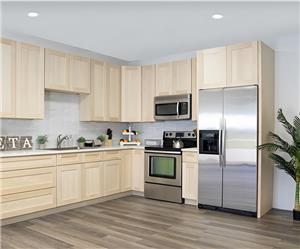Madera contrachapada, MDF y tableros de partículas: diferencia y comparación(3)
What is Plywood?
Out of the three, plywood is the sturdiest wood composite. This one is made up of several wood veneer sheets, pressed and bonded to develop a solid piece of engineered wood. The technique used to manufacture plywood is called cross-graining. It lessens expansion and shrinkage while increasing the strength consistency of the board.
The most notable characteristic of plywood is it has different grades depending on the purpose. The grade of plywood depends on the type of wood ply, the adhesive used, thickness, and the process of manufacturing. This means each grade differs a lot, making it essential you know about them to pick the right one based where or what you want to use it for.
Higher-grade plywood is great for making shelves and cabinets. On the other hand, lower-grade ones are perfect for subflooring. The plywood grade isn’t the only factor to consider when choosing plywood. It also has many different types with unique traits and different uses, which would be helpful to know.
Types of plywood:
The different types of plywood are:
Softwood – great for grooved flooring
Hardwood – often used for heavy-duty flooring or wall structures
Decorative – the type you can easily draw on and dye
Flexible – plywood that you can use for curved parts
Tropical – this type is a soft, low-cost wood
Marine – the kind of plywood perfect for boats and docks
Aircraft – this plywood has high heat and humidity resistance and high strength
Quality & Cost
Plywood is one of the most durable wood composites. It is the engineered wood you want to use for anything sturdy, be it a door or a shelf. However, this quality is based on the grade, which defines the toughness of the wood composite. As for the cost, it will depend on the size but it can range from $5 to $55 per sheet.
Advantage of Plywood
Plywood has several advantages, such as durability and strength far better than MDF wood. It can be made from different species of wood and has a wide range of thicknesses. Compared to MDF, it sustains less water damage. There are plenty of benefits to using plywood, including:
Smooth surface
Easily painted or shaped
Holds screws well
Easily cut into different shapes
Resistant to cracking, warping, twisting, or shrinking
Available in big size
Economical to use
Disadvantage of Plywood
Plywood has many benefits, but its disadvantages are almost as much. For one, it is more costly than MDF wood. Its edges often splinter during transportation, not to mention the layers are exposed. This makes it so that you must finish the edges with veneer or laminate. Other disadvantages of plywood include
Hard to cut
Can be damaged by water
Can cause eye irritation due to volatile organic compound
Must be covered with laminates to increase the lifespan
Susceptible to termites
Particle Board, MDF & Plywood Grades
The voids and knot holes on the composite wood make the difference between particleboard, MDF, and plywood. These defects show the quality of each composite wood, specifically the amount and extent of repair needed. Another factor that affects their grading is the type of adhesive.
Grade Description
A – Small patches, knots, and burls
B – Slight color streaks, small patches, burls, pin knots
C – Sound knots, smooth patches, slight discoloration
D – Significant defects demoting premium or good panels
G1S – Designation applies by dealers that means “Good 1 Side”
You can find out the grade of composite wood from the stamp “APA The Engineered Wood Association.” It should have the letters A, B, C, or D that indicates the grade. The A is the highest grade, which means their composite wood has minor defects. Meanwhile, D means defects downgraded the composite wood.

Comparison of Plywood, MDF, and Particle Board
Here is a quick comparison between plywood, MDF wood, and particleboard.

What is the right material for modular kitchen cabinets?
Laminates like particleboard, MDF, and plywood are all excellent materials to use for modular kitchen cabinets. They are great because they have high durability, high moisture resistance, and cost-effective. However, plywood is perhaps the best choice out of the three.
The problem with plywood is it’s susceptible to water damage. But you can remedy it by choosing the right type of plywood to use. You also have to make sure proper installation, whether it is plywood, particleboard, or MDF wood. With proper installation, you can ensure that the composite wood’s edges don’t peel off.
Which to choose – plywood or MDF or particleboard for wardrobes?
Wardrobes are shelves for clothes, which need more durability. On that note, the most preferred choice to use for making wardrobes is plywood. This composite wood is a lot more durable than particle board and MD. Since wardrobe is often used roughly, plywood makes a long-lasting option.
Plywood is made of sheets of wood veneer put together, with strength evenly distributed to create solid layers. It is the strongest wood composite and yet also lighter and much easier to work with, which makes it highly versatile. It goes to say this is the material you would want to use for a custom wardrobe.
What’s The Best Wood Solution?
The best wood solution comes down to the purpose. If it’s a cabinet, you can use any of them but plywood makes the best choice. But if you want to save money, you can use MDF for the shelving unit instead. You don’t really need to use a single type of wood for your project, so your choice doesn’t have to be limited.




